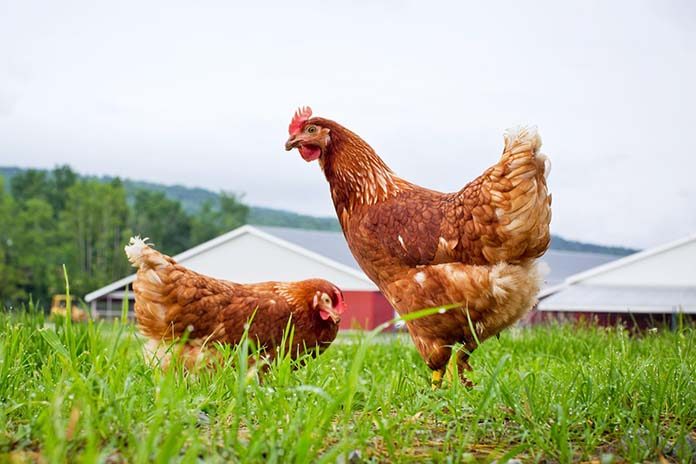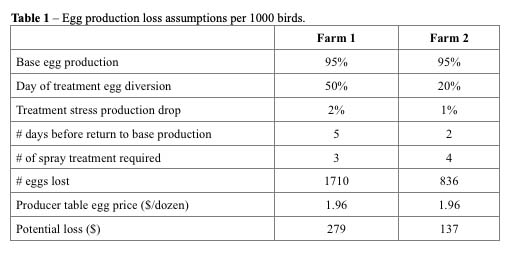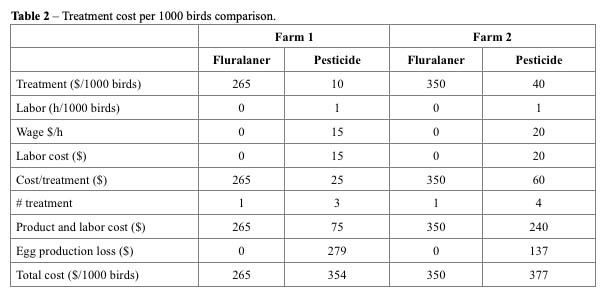
Once mites are observed in one area of the barn they tend to progressively spread to the whole barn and subsequently to the next barns of the site. Infestations affect bird comfort before causing skin lesions and reducing egg quality and production. Once mites are observed, producers increase biosecurity to keep the mites on the site and may add sulfur to the diet as it anecdotally reduces mite activity and/or reproduction rate. Once the farm personnel have complained enough, topical pesticides are typically applied on and under the birds.
The topical application is very labor intensive, the work is very unpleasant, the birds are soaked and stressed, and multiple weekly applications may be required. Disposition of the eggs that are on the belt during the application is also a topic for debate. However, the most concerning fact is that multiples of the label dose are occasionally used to achieve control and this practice is not allowed by the Health Canada Pest Management Regulatory Agency.
Fluralaner is a systemic poultry acaricide indicated for the treatment of poultry red mite (Dermanyssus gallinae) and northern fowl mite infestation in pullets, breeders and layer hens with a zero egg and 14 days meat and offal withdrawal in several countries.
Materials and methods
Two independent veterinarians following three commercial layer farms with northern fowl mite infestations elected to ask for fluralaner under Health Canada Veterinary Drug Directorate Emergency Drug Release program. Farms ranged from 3 to 5 barns joined by a front hallway and housing a total of 38000 to 200000 hens in either conventional or enriched housing. Birds were 38 to 60 weeks old at treatment. Lines represented include Lohmann white, Dekalb white, Shaver white, ISA brown, Hy-Line brown.
Fluralaner 1% aqueous solution was given twice 7 days apart at a dose of 0.5 mg/kg of body weight per treatment. The complete course of treatment must be administered to maintain a continued therapeutic concentration for 14 days and obtain the therapeutic effect for approximately 2 mite life cycles. First treatments were given June 13, October 25, and November 23, 2018. The product was applied by drinking water using dosing pumps set at either 1:100 or 1:128. Sulfur was inadvertently left in the feed for ~11 days post-treatment in Farm 2.
Diagnosis was confirmed by a combination of visual macroscopic and microscopic observations of the mites from the environment and from the birds’ vent area (3/3 farms) and mite identification by a third-party laboratory (1/3 farms). Treatment efficacy was assessed by sporadic visual macroscopic and microscopic observations from the environment and/or from the birds’ vent area. Post-treatment safety and production impact was determined from the review of the regular farm records.
Results
Farm 1 and 2 remained mite-free as of April 2019. Farm 3 reported seeing no live mites either on the birds or on the eggs 5 days post-treatment start; however, they were still seeing live mites in the floor dust in the front of one barn and they sprayed this area with a pesticide. Farm 3 also found a total of three mites from 60 dust samples on day 17. Premise spray was used in the front and back of the affected barn. No mites were found at the next check done on day 22. One worker observed mites 2 months later in Farm 3. Production remained within flock target and no side effects were observed.
Economical analysis and discussion
One must consider labor involved and egg diversion to compare treatment cost. There is no egg withdrawal following a topical pesticide application and eggs are suitable for human consumption when approved products are used as directed. However warm eggs that are sprayed are certainly a concern. The analysis included egg diversion of accidently sprayed eggs and used the 2018 egg farmers price.
Farm 1 had their last infestation in the mid-1990s which they managed to eradicate over a two-year period by spraying all barns twice and pullets once before arrival. They reported a production cost to the chronic infestation they endured. They qualified the 2018 infestation as the worst they ever had, and they sprayed the worst barn 3 times at 7 days interval with permethrins starting mid-May. Following each application, they observed ~2% production drop for 5 days. This intervention did not eliminate mites on bird and they decided to use fluralaner about a month later. Given the size of the farm and the time it took to spray, about 50% of each “spray day” production was diverted. Egg diversion and production loss associated with 3 pesticide treatments cost more than a successful treatment with fluralaner.
Farm 2 had a mite infestation in 2017 and 4 consecutive weekly pesticide treatments at 4 times the concentration were required to eliminate the infestation. The workers reported suffering from shoulder and back issues following this chore and the farmer reported a 1% production drop for 2 days after each treatment. In this case they brought in enough personnel to spray over a shorter period and only 20% of each spray day production was diverted. In this case both treatments were effective and the cost of either treatment considering product, labor, and egg loss was equivalent.
Farm 3 did a particularly thorough post-treatment environmental sampling that lead to the discovery of 3 live mites from the dust of the manure roller and elected to add a premise treatment of this barn as a precaution. This farm is older, equipment is stored in open shelves in the hallway, and there is always a large amount of dust present.
Farm 1 & 2 only treated with fluralaner and did not spray the premise with an insecticide and those two sites are still mite-free. We suspect that season – mites are less active in colder temperature- sub-optimal de-cluttering and cleaning, dust disposal, severity of the infestation, age and state of repair of the barn, may have contributed to the early re-infestation of Farm 3.
The veterinarians and their clients found that the benefits of a systemic treatment applied via the water include a reduced food safety concern with egg exposure to aerosolized insecticide particles; reduced risk of workers injury associated with application, topical exposure, and respiratory exposure to the insecticide; reduced biosecurity risk associated with bringing in the additional help to spray birds; reduced stress on birds from being sprayed, soaked, and exposed insecticide vapors; and maintaining compliance with Canadian regulatory agencies.
When considering the ease of administration, the labor cost, the predictable efficacy, and the intangible yet sizeable benefits cited above farmers considered the fluralaner regimen a good value and would choose it again over traditional topical pesticide spray.


References
Hinkle NC, Jirjis F, Eugene Szewczyk, Sun F, Flochlay-Sigognault A. Efficacy and safety assessment of a water-soluble formulation of fluralaner for treatment of natural Ornithonyssus sylviarum infestations in laying hens. Parasites & Vectors 2018 11:99. https://doi.org/10.1186/s13071-018-2678-y

















